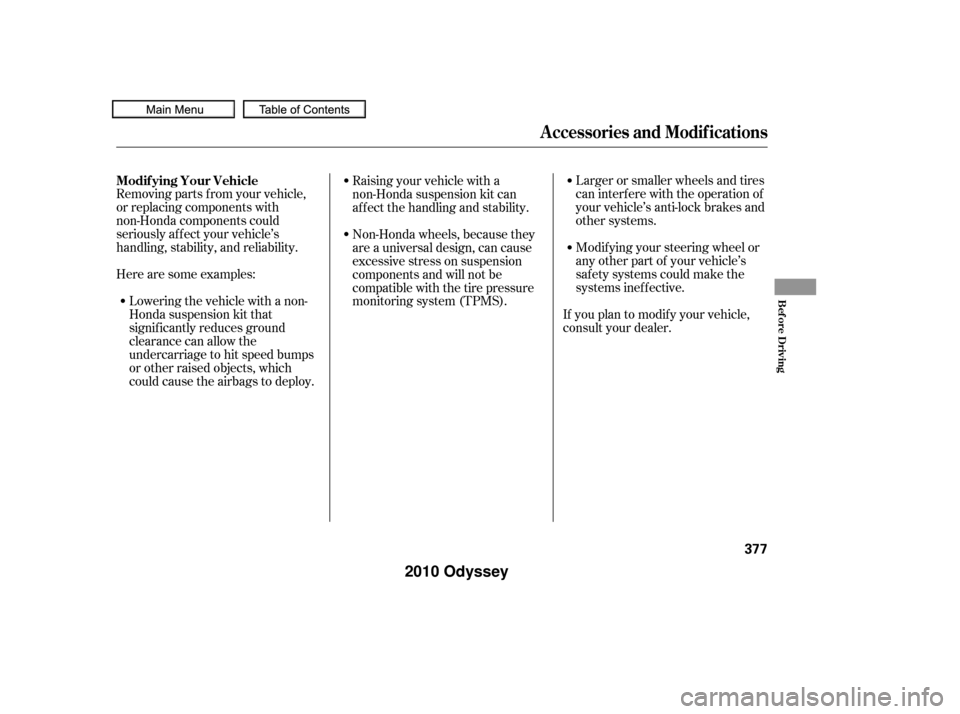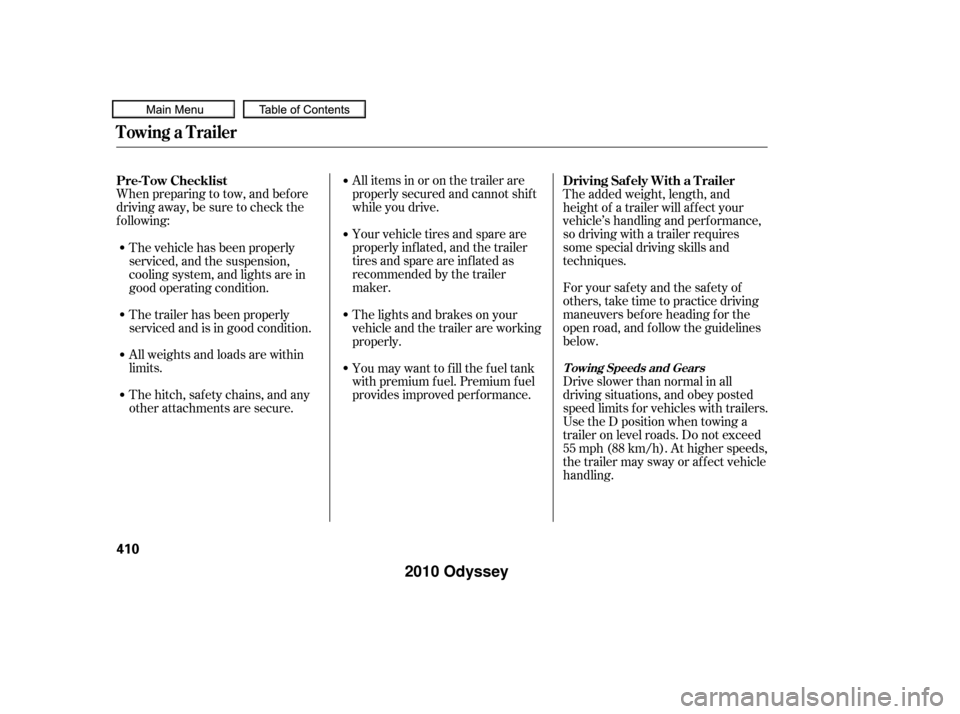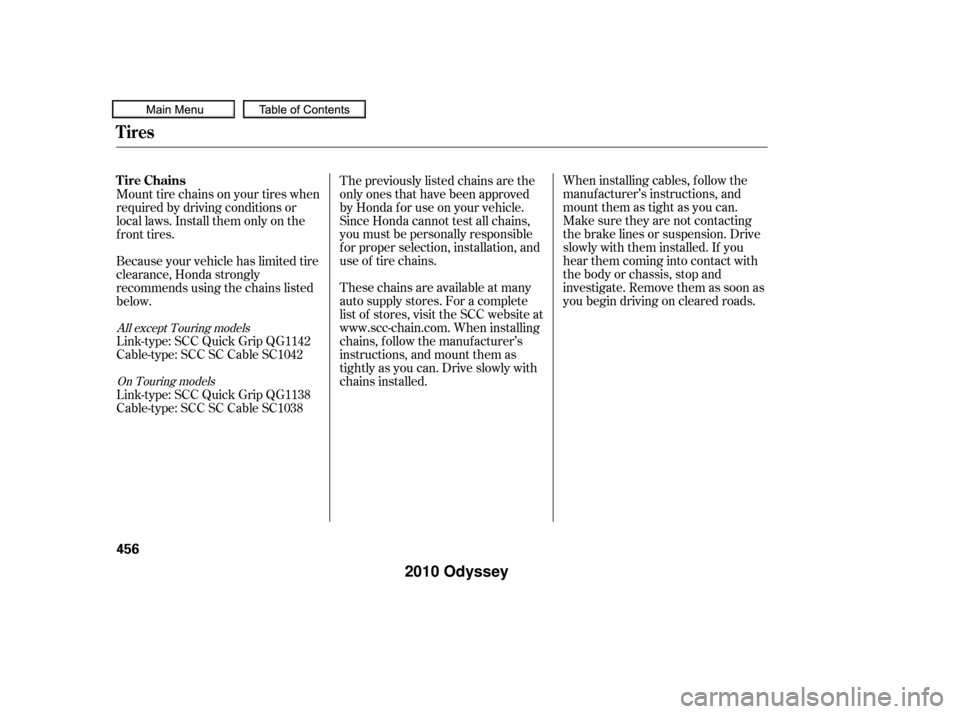Page 380 of 526

Removing parts f rom your vehicle,
or replacing components with
non-Honda components could
seriously af f ect your vehicle’s
handling, stability, and reliability.Larger or smaller wheels and tires
can interf ere with the operation of
your vehicle’s anti-lock brakes and
other systems.
Modif ying your steering wheel or
any other part of your vehicle’s
saf ety systems could make the
systems inef f ective.
Raising your vehicle with a
non-Honda suspension kit can
af f ect the handling and stability.
Herearesomeexamples: Lowering the vehicle with a non-
Honda suspension kit that
signif icantly reduces ground
clearance can allow the
undercarriage to hit speed bumps
or other raised objects, which
could cause the airbags to deploy. Non-Honda wheels, because they
are a universal design, can cause
excessive stress on suspension
components and will not be
compatible with the tire pressure
monitoring system (TPMS).
If you plan to modif y your vehicle,
consult your dealer.
Modif ying Your Vehicle
A ccessories and Modif ications
Bef ore Driving
377
�����—�����—�
���y�
�������������y���
�(�����������y���������y
2010 Odyssey
Page 413 of 526

When preparing to tow, and bef ore
driving away, be sure to check the
f ollowing:All items in or on the trailer are
properly secured and cannot shif t
while you drive.
Your vehicle tires and spare are
properly inf lated, and the trailer
tires and spare are inflated as
recommended by the trailer
maker.The added weight, length, and
height of a trailer will af f ect your
vehicle’s handling and perf ormance,
so driving with a trailer requires
some special driving skills and
techniques.
Foryoursafetyandthesafetyof
others,taketimetopracticedriving
maneuvers bef ore heading f or the
open road, and f ollow the guidelines
below.
Drive slower than normal in all
driving situations, and obey posted
speed limits f or vehicles with trailers.
Use the D position when towing a
trailer on level roads. Do not exceed
55 mph (88 km/h). At higher speeds,
the trailer may sway or affect vehicle
handling.
The vehicle has been properly
serviced, and the suspension,
cooling system, and lights are in
good operating condition.
The trailer has been properly
serviced and is in good condition.
All weights and loads are within
limits.
Thehitch,safetychains,andany
other attachments are secure.
The lights and brakes on your
vehicle and the trailer are working
properly.
You may want to fill the fuel tank
with premium f uel. Premium f uel
provides improved perf ormance.
Pre-T ow Checklist
Driving Saf ely With a T railer
T owing Speeds and Gears
Towing a Trailer
410
�����—�����—�
���y�
�������������y���
�(�����������y�����
���y
2010 Odyssey
Page 427 of 526

�µ
�µ
�Ì
�Î
�Î
�Ì �Ì
�Î
Maintenance Minder
424
:
If the message ‘‘SERVICE DUE NOW’’ does not appear more than 12 months
after the display is reset, change the engine oil every year.
See information on maintenance and emissions warranty on page .
Inspect idle speed every 160,000 miles (256,000 km).
Adjust the valves during services A, B, 1, 2, or 3 only if they are noisy. Independent of the maintenance messages in the information display,
replace the brake fluid every 3 years.
NOTE: 1:
423
Maintenance Sub Items
Rotate tires
Replace air cleaner element If you drive in dusty conditions, replace
every 15,000 miles (24,000 km).
Replace dust and pollen filter If you drive primarily in urban areas that have high
concentrations of soot in the air from industry and
from diesel-powered vehicles, replace every 15,000
miles (24,000 km).
Inspect drive belt
Replace transmission fluid
Replace spark plugs
Replace timing belt and inspect water pump If you drive regularly in very high temperatures (over
110°F, 43°C), in very low temperatures (under 20°F,29°C), replace every 60,000 miles (U.S.)/100,000 km
(Canada).
Inspect valve clearance
Replace engine coolant
Maintenance Main Items
Replace engine oil
Replace engine oil and oil filter
Inspect front and rear brakes
Check parking brake adjustment
Inspect these items: Tie rod ends, steering gear box, and boots
Suspension components
Driveshaft boots
Brake hoses and lines (including ABS/VSA)
All fluid levels and condition of fluids
Exhaust system
Fuel lines and connections
A
B
Symbol
Symbol
1
2
3
4
51
1
Maintenance Minder
�����—�����—�
���y�
�������������y���
�(�����������y���������y
2010 Odyssey
Page 459 of 526

When installing cables, f ollow the
manuf acturer’s instructions, and
mount them as tight as you can.
Make sure they are not contacting
the brake lines or suspension. Drive
slowly with them installed. If you
hear them coming into contact with
the body or chassis, stop and
investigate. Remove them as soon as
you begin driving on cleared roads.
The previously listed chains are the
only ones that have been approved
by Honda f or use on your vehicle.
Since Honda cannot test all chains,
you must be personally responsible
f or proper selection, installation, and
useof tirechains.
These chains are available at many
auto supply stores. For a complete
list of stores, visit the SCC website at
www.scc-chain.com. When insta
lling
chains, f ollow the manuf acturer’s
instructions, and mount them as
tightlyasyoucan.Driveslowlywith
chains installed.
Because your vehicle has limited tire
clearance, Honda strongly
recommends using the chains listed
below. Mount tire chains on your tires when
required by driving conditions or
local laws. Install them only on the
f ront tires.
Link-type: SCC Quick Grip QG1142
Cable-type: SCC SC Cable SC1042
Link-type: SCC Quick Grip QG1138
Cable-type: SCC SC Cable SC1038
All except Touring models
On Touring models
Tires
Tire Chains
456
�����—�����—�
���y�
�������������y���
�(�����������y�������
�y
2010 Odyssey
Page 460 of 526
Tires
Maint enance
457
Using the wrong chains, or not
properly installing chains, can
damage the brake lines and
cause a crash in which you can
be seriously injured or killed.
Follow all instructions in this
owner’s manual regarding the
selection and use of tire chains.Traction devices that are the wrong
size or improperly installed can
damage your vehicle’s brake lines,
suspension, body, and wheels. Stop
driving if they are hitting any part of
the vehicle.
�����—�����—�
���y�
�������������y���
�(�����������y���������y
2010 Odyssey